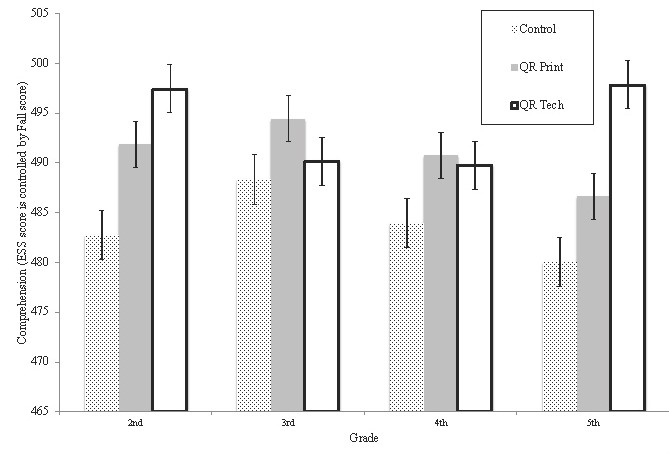Examining the Impact of QuickReads Technology and Print Formats on Fluency, Comprehension, and Vocabulary Development for Elementary Students
Summary by: Yining Hua
What is QuickReads Technology? Is it effective?
QuickReads (QR) is a curriculum that uses science and social studies texts to build reading skills. It has both print-only and technology + print formats and utilizes 15-minute instructional sessions built on a model with wide and long-lasting support in comprehension instruction. This study finds that QR enhanced students’ reading skills in all evaluated areas: reading fluency, reading comprehension, and vocabulary. The figure shows the outcome of the reading comprehension assessment. The three bars within each grade group represent students who 1) did not use QR (control), 2) used QR print materials, and 3) used QR technology-based and printed materials, respectively (from left to right). Across all grades, QR effectively enhanced students reading fluency.

How was the study conducted?
The study was a 19-week randomized experiment including 1,484 students in 2nd through 5th grade from 76 classrooms at nine K–5 elementary schools in a midwestern city. Students in this study closely resembled district ethnicity populations, were at all achievement levels, and included English Language Learners. The 76 classrooms were randomly assigned to receive no QR materials, print-only QR materials, or technology + print QR materials. Before the random assignment, students in each class were tested and grouped into three levels based on their reading test scores. Then, the research team randomly selected 4 students at each level per class for an individual reading skills assessment. Reading fluency was evaluated using the standardized DIBELS Oral Reading Fluency test, an individually administered test of reading accuracy and rate. Reading comprehension and vocabulary were evaluated by the form-referenced Gates-MacGinitie test.
Advantages of technology + print vs. print
While there was no statistically discernable advantage of the technology-based QR over the printed version, the pattern of findings suggest a potential advantage of using technology + print QR over the printed materials. The technology-based QR removed the need for performance in front of peers and teachers. Instead of reading aloud to peers or teachers, students could record their oral reading on computers. As a result, the authors speculate that students that were too shy to do oral readings in front of others would not have decreased performance and opportunities for practice. Additionally, teachers in the study reported that students who hesitated to practice out loud often increased practice time through using technology, which might have increased overall student performance. Moreover, the technology format is automatic with continuous highlighting of text on the screen in two- to four-word phrases, which might also have contributed to enhancing students’ concentration.
Full article citation:
Trainin, G., Hayden, H.E., Wilson, K. & Erickson, J. (2016): Examining the Impact of QuickReads Technology and Print Formats on Fluency, Comprehension, and Vocabulary Development for Elementary Students, Journal of Research on Educational Effectiveness, 9(1) p.93-116. DOI: 10.1080/19345747.2016.1164778.
